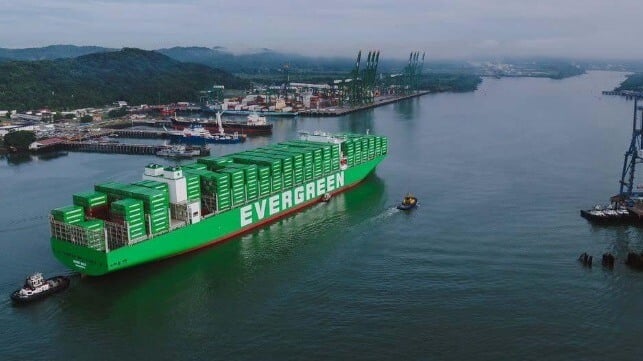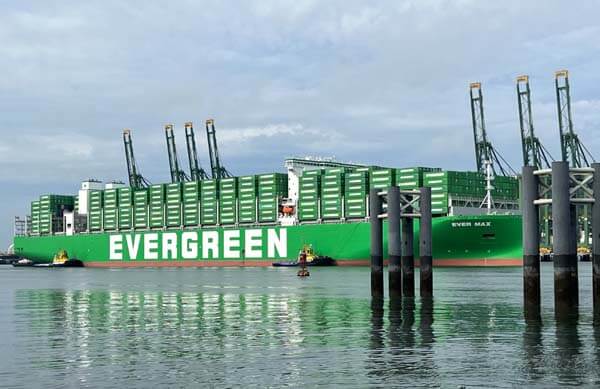Panama Canal’s Limits Force New "Largest" Boxship to Offload Before Transit

The transit of the new containership Ever Max through the Panama Canal’s Neopanamax Locks on Tuesday, August 1, highlights the challenges faced both by the Panama Canal and the container shipping industry. What could have been the largest container shipment to transit the canal in its 109-year history instead found itself limited in the number of boxes both due to the decline in traffic and the Panama Canal’s draft restrictions to save water during the prolonged drought.
Delivered to Taiwan’s Evergreen shipping company in June 2023, the new Ever Max is 160,000 dwt and was deployed on the route between the Asian ports of Xiamen, Kaohsiung, Hong Kong, Yantian, and the North American ports of Savannah, Newark, Norfolk, and Baltimore. At 1,200 feet in length and with a 167-foot beam she is given a nominal carry capacity of 17,312 TEU.
Her size makes the Ever Max among the largest containerships scheduled to transit the Panama Canal. Her dimensions are equal to that of CMA CGM Zephyr which a year ago claimed the title of carrying the largest container load through the canal with 16,285 TEU. The Triton operating in 2019 for Evergreen with a length of 1,210 feet and 14,000 TEU capacity became the largest boxship to transit the Neopanamax locks and remains the largest vessel by size but no longer capacity.
The Panama Canal Authority is highlighting that the Ever Max is the largest capacity containership to transit the Canal, however, she went through with just 13,345 TEU. She arrived at Balboa on the Pacific side of the canal at the beginning of the week with 14,745 TEU aboard. Her maximum draft, however, exceeds the canal’s normal 50-foot maximum for the Neopanamax locks. Already 15 percent below capacity due to the market, the Panama Canal required the boxship to reduce its load to meet the 44-foot maximum permitted draft.

Ever Max docked in Panama for the transshipment of 1,400 boxes across the isthmus (AMP photo)
"When this historic transit is completed, the efficiency and solidity of the interoceanic highway is evident as a fundamental maritime transport route for global trade, despite the challenges imposed by climate change," said the deputy administrator of the Panama Canal, Ilya Espino de Marotta. The AMP is using the transit to say the Panama Canal remains competitive despite the limits.
The Ever Max however had to offload 1,400 TEU in Balboa for transshipment across the isthmus via train before the transit. After completing the trip through the Canal on August 1, the Ever Max is now at the container terminal in Colon reloading the boxes that were moved by train.
In late July, the Canal Authority said that it had decided it would be possible to delay further draft restrictions maintaining the 44-foot level for the next few months, “as long as weather conditions do not vary significantly from current projections.” They had been decreasing the draft at half-foot increments.

that matters most
Get the latest maritime news delivered to your inbox daily.
To maintain the water levels, however, the canal quietly began reducing the number of daily transits through the locks in addition to requiring some of the boxships to reduce the load with similar transshipments to the one for the Ever Max. The Panama Canal can handle a maximum of approximately 40 daily transits and normally was handling 34 to 36 ships a day. Now the canal is taking a maximum of 32 a day with only 10 at the larger Neopanamax locks and 22 in the older locks which accommodate smaller ships.
The concern has been that waiting times would increase further at the Panama Canal. However, maintaining the draft level is critical because as it continues to fall it could begin to impact gas carriers which so far have been below the maximum.
